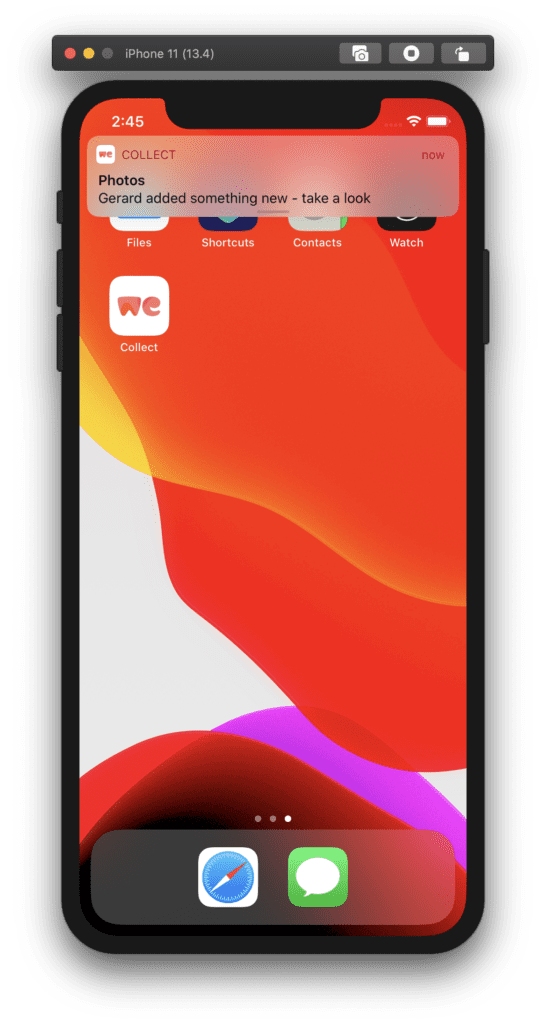Open Iphone Simulator Mac
- To run your app in Simulator, choose an iOS simulator—for example, iPhone 6 Plus, iPad Air, or iPhone 6 + Apple Watch - 38mm—from the Xcode scheme pop-up menu, and click Run. Xcode builds your project and then launches the most recent version of your app running in Simulator on your Mac screen, as shown in Figure 1-1.
- Sometimes the iOS simulator doesn't respond to commands to open. If it seems to be stuck on this prompt, you can open the iOS simulator manually (open -a Simulator) and then in the macOS toolbar choose Hardware → Device and select an iOS version and device that you'd like to open.

From the XCode menu, select Open Developer Tool Simulator In the dock, control (or right) click on the Simulator icon Select Options Show in Finder While holding down Command and Option, drag the Simulator icon to the applications directory. User4166 posted On my new clean mac deploying an iphone app from Visual Studio crashes the simulator, and then the simulator can not be opened ever again. I have a problem with Xamarin and the iphone simulator running on my new Mac with a clean installation of Mac OS 10.8.3. I have Xcode 4.6.1. User9 posted Can you paste in the information from.
- Windows 〉
- Mac 〉
- Ubuntu 〉
- Tablets 〉
- Kindle 〉
- Nexus 7 〉
- Galaxy Tab 2 〉
- iPad 〉
- Email 〉
- Outlook 〉
- Windows Mail 〉
- Web Mail 〉
- Outlook Express 〉
- Thunderbird 〉
- IncrediMail 〉
- Eudora 〉
- Browsers 〉
- Microsoft Edge 〉
- Internet Explorer 〉
- Firefox 〉
- Safari 〉
- Chrome 〉
- Opera 〉
- Security 〉
- Norton 〉
- McAfee 〉
- Microsoft 〉
- F-Secure 〉
- Avast 〉
- AVG Free 〉
- Kaspersky 〉
- Bitdefender 〉
- Networking 〉
- Router Emulators 〉
- D-Link 〉
- Asus 〉
- Router Emulators 〉
- Smart Phones 〉
- Windows Phones 〉
- iPhone 〉
- Samsung 〉
- HTC 〉
- Blackberry 〉
- TVs 〉
- Roku 〉
- Game Consoles 〉
- Misc 〉
- How Do I? 〉
- Helpful Links 〉
- Free Time? 〉

 -->
-->The Remoted iOS Simulator for Windows allows you to test your apps on aniOS simulator displayed in Windows alongside Visual Studio 2019 and Visual Studio 2017.
Getting started
The Remoted iOS Simulator for Windows is installed automatically as partof Xamarin in Visual Studio 2019 and Visual Studio 2017. To use it, follow these steps:
- Pair Visual Studio 2019 to a Mac Build host.
- In Visual Studio, start debugging an iOS or tvOS project. TheRemoted iOS Simulator for Windows will appear on your Windows machine.
Watch this video for a step-by-step guide.
Simulator window
The toolbar at the top of the simulator's window contains a number of useful buttons:
Open Iphone Simulator Mac Free
Home – Simulates the home button on an iOS device.
Lock – Locks the simulator (swipe to unlock).
Screenshot – Saves a screenshot of the simulator (stored in PicturesXamariniOS Simulator).
Settings – Displays keyboard, location, and other settings.
Other options – Brings up various simulator options such as rotation, shake gestures, and Touch ID.
Settings
Clicking the toolbar's gear icon opens the Settings window:
These settings allow you to enable the hardware keyboard, choose alocation that the device should report (static and moving locations areboth supported), enable Touch ID, and reset the content and settings forthe simulator.
Other options
The toolbar's ellipsis button reveals other options such as rotation,shake gestures, and rebooting. These same options can be viewed as a listby right-clicking anywhere in the simulator's window:
Touchscreen support
Most modern Windows computers have touch screens. Since the Remoted iOSSimulator for Windows supports touch interactions, you can test your appwith the same pinch, swipe, and multi-finger touch gestures that you usewith physical iOS devices.
Similarly, the Remoted iOS Simulator for Windows treats Windows Stylusinput as Apple Pencil input.
Sound handling
Sounds played by the simulator will come from the host Mac's speakers.iOS sounds are not heard on the Windows computer.
Disabling the Remoted iOS Simulator for Windows
To disable the Remoted iOS Simulator for Windows, navigate toTools > Options > Xamarin > iOS Settings and uncheckRemote Simulator to Windows.
With this option disabled, debugging opens the iOS Simulator on the connected Mac build host.
Troubleshooting
If you experience issues with the Remoted iOS Simulator, you can view the logs in these locations:
- Mac –
~/Library/Logs/Xamarin/Simulator.Server - Windows –
%LOCALAPPDATA%XamarinLogsXamarin.Simulator
Open Iphone Simulator Machine
If you report a problem in Visual Studio, attaching these logs might be helpful (there are options to keep uploads private).